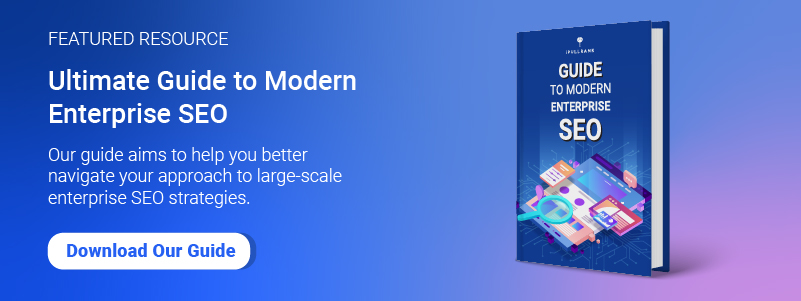In this webinar, Colt Sliva, SEO Engineer at iPullRank shared his tags and taxonomy knowledge for enterprise brands in the world of eCommerce. He’ll also show you how to use tags, site structure, and categories to increase your site’s discoverability.
Watch the replay here:
Here’s what we covered in this webinar:
- Why eCommerce taxonomy matters [3:47]
- Levels of eCommerce categorization [4:35]
- The ontology of eCommerce products [5:57]
- Why most brands do eCommerce navigation poorly [9:21]
- Which is better? Faceted navigation or faceted taxonomies [12:45]
- The web page your product pages should be grouped around [16:47]
- How many internal links are too many for Google? [19:32]
- The impact of tags and taxonomy on SEO growth [30:14]
- Achieving rapid results with tags and taxonomy [32:53]
- When thin content becomes a problem for SEO [35:01]
- Pitching tags and taxonomy to the C-suite [35:40]
Why eCommerce taxonomy matters [3:47]
Taxonomy is the starting point for how we think about products, organize them, and link everything together. And so, I want to give you a framework for writing better titles and meta descriptions. You can improve time-on-site, build topical relevance, design better URLs, and help Google’s crawlers find your content with good taxonomy. A well-designed taxonomy can also have a positive impact on enterprise SEO.
Levels of eCommerce categorization [4:35]
Naming things is a hard problem.
There are three levels of categorization if we’re referencing linguistics: the superordinate, the basic, and the subordinate. If you look at the graph below, the superordinate would be like a mammal, and then the basic would be a dog. And then the subordinate would be a specific kind of dog like a terrier.
The ontology of eCommerce products [5:57]
When labeling products, you want to think about what makes them different. That’s the study of ontology, the properties tags, facets, features, and attributes of a product. So again, we’re going to turn the frameworks. If we’re using Santa as our framework, we can map his traits.
Why most brands do eCommerce navigation poorly [9:21]
Most eCommerce sites end up with some category structure that sends traffic up and down (i.e., breadcrumb navigation). On the other hand, tags aren’t directing people laterally across the site. The assumption in many organizations is if you’re in a specific category (i.e., shoes), you may not want to move laterally (e.g., coats or socks), which, looking at the data, is an inaccurate assumption that’s bad for PageRank.
Which is better? Faceted navigation or faceted taxonomies? [12:45]
Faceted navigation isn’t as great as we think it is, even though it’s ubiquitous in eCommerce. It creates multiple versions of the same URL; that means duplicate content, diluted link equity, wasted crawl budget, and spider traps. What we need is true taxonomy pages for SEO. Taxonomy is ideal for organic landing pages because usually, the keyword ends up being in the URL, the title, descriptions.
The web page your product pages should be grouped around [16:47]
Your home page is the most central part of your site; it has the most value acquired from external links. If you want to increase the value of specific pages, bring them as close to the home page as possible or even within the main content area. It’s an extremely efficient way to increase PageRank.
How many internal links are too many for Google? [19:32]
Is it possible to have too many internal links? Is there a threshold that needs to be followed? At one time, Google mentioned an upper limit of 100, but that was proven false over time. Experience tells us that 200 is a good target for most websites, but there is no upper limit. The more internal linking you do, the flatter your PageRank distribution will be.
For large sites (1 million pages +), you’ll want to use more internal links. The home page receives the most external value, so it’s a good idea to focus on increasing internal linking, especially through tags and taxonomies. After that, you’ll also want to assign high-value pages somewhere close to the homepage.
The impact of tags and taxonomy on SEO growth [30:14]
Can taxonomy perform? Can you use internal linking to improve site architecture, crawling, and rankings?
Achieving rapid results with tags and taxonomy [32:53]
What are the top recommendations for someone who’s looking to make a change now, before a holiday like Black Friday; how might that impact their SEO?
When thin content becomes a problem for SEO [35:01]
Some platforms like WordPress have out-of-control editors that produce tons of tag pages highlighting only a single post. Is this kind of thin content a problem worth addressing?
It’s no a cause for alarm unless you see negative results. Thin content becomes a problem if you are getting keyword cannibalization. If you see a decrease in traffic on the pages you want traffic to, it’s a good idea to trim those tags. If we’re focused purely on Google updates and content, it’s not necessarily an automatic cause for alarm.
It’s still a good idea to set some kind of company standards for tagging, though.
Pitching tags and taxonomy to the C-suite [35:40]
What’s the best way to get C-suite buy-in so you can implement a full rollout of tags and taxonomy? Sure, you could share the benefits of improving user navigation, but there’s not much data on that. That’s not a problem because the data is pretty clear on the benefits of the internal linking.
Show executives the data that demonstrates 40% and 76% increases in organic traffic. Lead with value and results, so it’s immediately clear that you’ll achieve a pretty significant boost with good information architecture.
About Colt Sliva, SEO Engineer at iPullRank
Colt has 10+ years making websites and acquiring organic traffic. Currently, he’s an SEO Engineer at the iPullRank Agency. His specialties include Natural Language Processing and Information Architecture.
About Garrett Sussman, Demand Generation Manager at iPullRank
Garrett is a digital marketing veteran with 10+ years of experience. He’s a T-shaped authority, a broad generalist with all things digital marketing, and deep expertise in content strategy, search, email, and social media marketing.
- The Cost of SEO Services in 2024 - January 4, 2024
- The 2024 SEO Guide To Successful Website Migration - April 4, 2023
- How Audience Research Shapes Financial Services Marketing - February 16, 2023












Leave a Comment